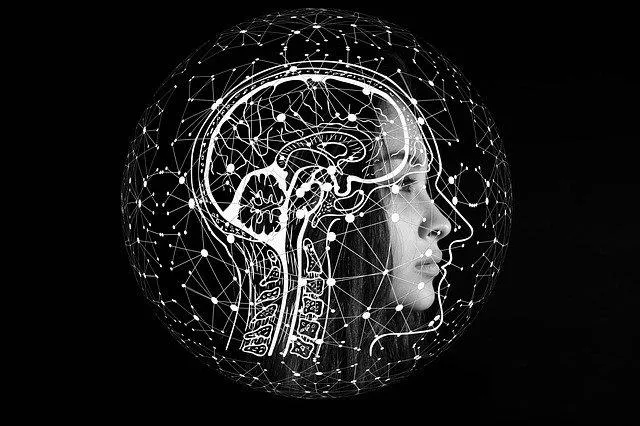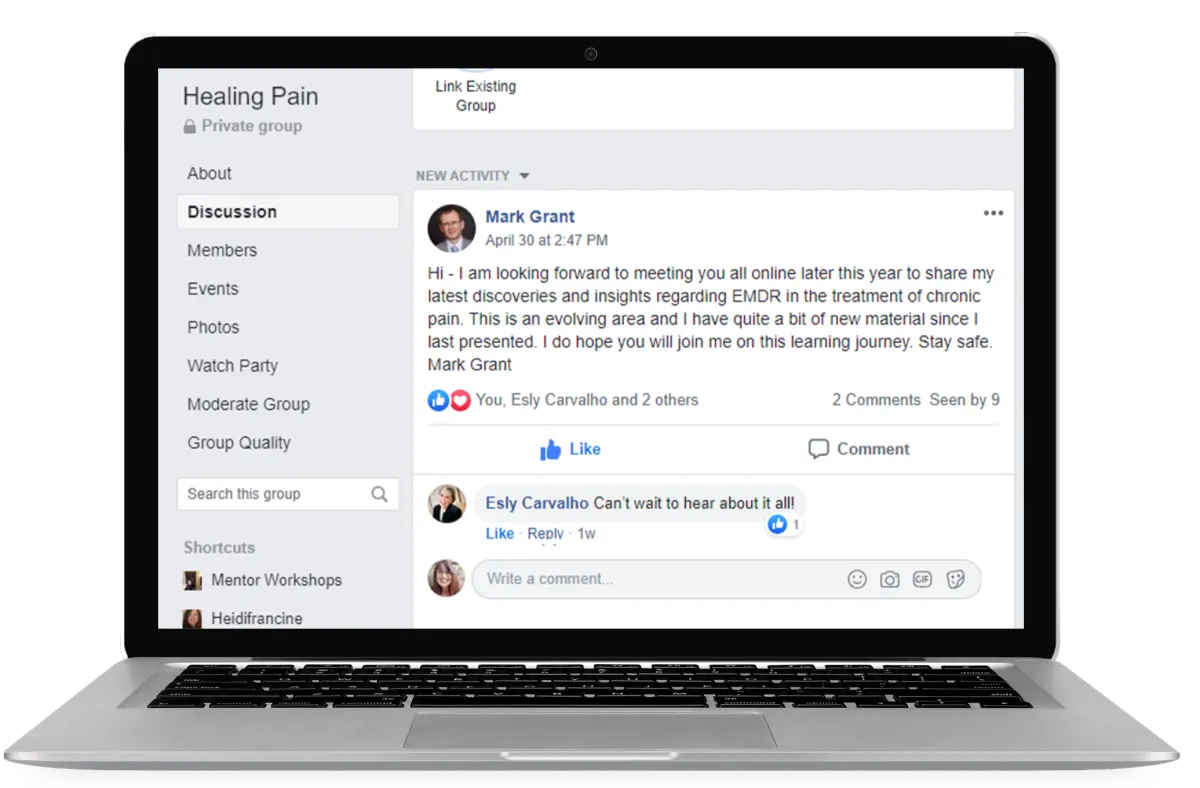
" EMDR Therapy
Treatment of Medically Unexplained Pain!"
With Mark Grant: Online Course

What You Get:
The following Self-Paced Course +
2 - Two hour live webinars for Q & A,
Case Consultation and a surprise bonus from Mark and Heidi!
- Exclusive Course, with slides, demonstration videos, downloads and more.
- 14 EMDRIA credits
- Free digital Copy of Mark's Newest Book.
- Access to an exclusive, private Facebook group for networking, discussions and content updates.
- A discount on the even more advanced 2 day in person workshop.
- Success in healing and reducing pain.


1000s Taught

Published in Scholarly Journals

Researched 30 Years

Hundreds of Thousands Healed
Are You Ready for Mark Grant's Online Course?
What's New This Year With Mark Grant
Due to the Corona Virus, we have been forced to postpone the live workshop of this amazing course. Sometimes, you've got to make lemonade - so we have taken this as an opportunity to bring this ground breaking material to a new format, thus making it accessible to everyone around the world. You will be able to stop and digest important information and listen again to give you added confidence when treating your clients with this hugely successful protocol.



What This Course Will Cover

Unexplained pain is a significant element of many psychological problems, particularly complex trauma and PTSD. Traditional methods have struggled to meet the challenge of pain.
Similar to its effects with PTSD, EMDR therapy appears to stimulate a change in the somatic component of pain coupled with associated emotional and cognitive responses. The method also seems to be consistent with Neurologically informed views about psychological treatment.
This two-day workshop will review current theories of pain management, including neurological models and the role of adverse experiences in childhood in precipitating somatic symptoms. A phased, trauma-based approach to pain will then be presented. The emphasis will be on the skills of evoking and integrating sensory-emotional material, down-regulating arousal levels (including pain relief as a goal), addressing other mental and existential aspects of pain and promoting a more wholistic self-caring stance in clients with somatic problems.
Course Contents
1. Intro
A trauma-informed approach to overcoming pain
Historical origins of the current mind-body debate
Pain in the brain
2 practical implications of understanding pain in the brain
How severe stress leads to pain
Pain as a memory
Evolutionary theories of chronic pain
Why EMDR? Neurological and aetiological indications
2. Pain Protocols 1-3
EMDR therapy protocol for chronic pain
7 steps/phases of pain management
EMDR treatment Stages 1-3 (History – Assessment
Case conceptualization (trauma vs pain, personality factors, priorities)
Red flags (medical treatment issues, other stress, dissociation)
Integration case conceptualization and treatment planning
EMDR treatment of pain flowchart
Differences when targeting and processing pain compared with trauma
How to select develop EMDR pain "targets"
How to know when to commence EMDR reprocessing
Case conceptualization vignettes
3. Pain Protocols 4 - 8
EMDR Pain protocol stages 4-7
Bilateral stimulation differences
Using sensory focus to facilitate change
Conversion disorder (FNSD) case example
Installing positive cognitions
Resource installation
Body scan and treatment decisions
Dealing with incomplete processing
4. Resources Installation
4 types of pain resources
Guided imagery or BLS?
How to create resources based on post BLS somatic changes
Words of comfort
The ‘wild card’ question
Demonstration with medical pain (video)
5. Adjunctive strategies
6 Descending pain management strategies
5 Ascending pain management strategies
Personality factors and strategy selection
4 Hypnotic pain management strategies
MPS/TMS approach (healing negative emotions)
Overcoming pain app
Brain training to control pain
3 ways to use touch to relieve pain
Physical self-care basics
Video demonstrations of; pendulation, antidote imagery,
contralateral stimulation
6. Post Traumatic Pain
Overview of treatment challenges and principles and practices
Demonstration of treatment practices via 4-case studies;
EMDR treatment of whiplash pain (case description and video)
EMDR treatment of severe leg injury (case description and video)
EMDR treatment of GAD/CFS (case description and video)
EMDR treatment of vaginisumus (case description)
Treatment tips
Using sensory focus to facilitate change
7. Functional Pain
Targeting
Balancing the body and the mind
Sensory Focus
Integration with adjunctive therapies
8. Medical Pain
4 key things to look for when assessing clients with medical pain
EMDR treatment of gallstones pain (case description and video)
EMDR treatment of chronic low back pain (case description and video)
How and when to integrate adjunctive interventions
EMDR resistant diagnoses (eg; CRPS).
9. Dealing with dissociative phenomena in pain
Dealing with dissociative phenomena in pain
4 most common dissociative phenomena in chronic pain
How to recognize dissociative phenomena in pain sufferers
How pain affects dissociative defences
How to use dissociation to help manage pain
Parts work with pain sufferers
10. Dealing with blockages to EMDR Therapy processing
Understanding Blockages
9 common ‘blockages’ when using EMDR to reprocess pain
Tips for addressing ‘blockages’
Cognitive interweaves for facilitating processing
The ‘inner-voice’ question
S.1 How to maximize effects of BLS
S.1 How to maximize effects of BLS
Research review regarding role of BLS in EMDR
The Orienting Response theory
4 types of attention activated by BLS
Visual, auditory or tactile?
6 physical effects of BLS
6 mental effects of BLS
9 tips for maximizing the effects of BLS
S.2 Pain protocol walk though
Understanding the purpose of the protocol
AIP model and pain
Targeting pain
Negative Cognition
Positive Cognition VoC options
Desensitization (special considerations when working with pain)
Installation (PC and antidote imagery)
Closure
Why Treat Medically Unexplained Pain
Doctors often struggle to figure out why pain persists in the body or why there is pain when scans and ex-rays read normal. Chronic pain is 60% of all doctor visits and often leaves people feeling hopeless and more stressed. Isolation, depression and many other psychological factors increase the body's inability to cope or manage pain.
Doctors have limited time to spend with their patients, and understand the depth of their pain. This often leaves doctors over-prescribing pain killers in an effort to help them manage and cope with pain.
Through this course you will be able to understand, at a deeper level chronic pain and what you can do to ease your clients suffering. The relief you will be able to give your clients will amaze them and you.
.



Regarding The Research
A Cochrane review concluding that new ideas are needed. Since its emergence as a treatment for PTSD, EMDR has shown efficacy with a range of problems, including chronic pain. Efficacy has been reported with Phantom limb pain, headaches, low back pain and somatization pain and the method’s research base is growing.
A study of five cases of phantom limb pain reported a complete cessation of pain in two cases and reduced frequency and/or intensity in
the remaining three (Schneider, Hoffman, Rost, & Shapiro, 2007). In a case study by Grant and Threlfo (2002), three chronic pain patients reported decreased pain levels, decreased negative affect, and increased
ability to control their pain following the EMDR intervention. Other
.Journal research on EMDR therapy shows significant results on healing and or reducing chronic pain. "People are living longer and want quality of life!" Stated Dr. Katz.

Who is Mark Grant?

Mark Grant is a psychologist with over 30 years experience treating sufferers of pain and stress. Mark has been developing and researching the use of EMDR in the treatment of chronic pain for over 25 years.
In addition to his clinical work Mark has studied and written about the problem of stress and pain, mainly for fellow professionals, although his ideas have also been cited in the New York Times (11/6/7 – ‘Living With Pain That Just Won’t Go Away’). Mark is the author of a chapter in the edited volume Eye Movement Desensitization and Reprocessing EMDR Scripted Protocols (Springer, 2008) and the forthcoming clinician guide/self-help manual “Change Your Brain Change Your Pain” and has published several articles on the subject, including in the Journal of Clinical and Consulting Psychology.
Mark has presented at conferences and workshops in Australia , the Americas and Europe . His self-help CD’s were the subject of an award of merit for didactic material from the University Education Distancia ( Madrid ) in 2007. Since 2005 Mark has worked in partnership with his wife Ana , who is also a psychologist. He was the chairman of the EMDR Association of Australia from 2000 – 2008.

What Previous Attendees are Saying
.When the pain leaves their body they don't want to move. "The healing stays," I often say to my clients. when they realize what work we did sticks, they become very relaxed and leave smiling.
Linda Vanderlaan phd
"Honestly, I think Mark Grant is one of the smartest people today. He is so genuine, compassionate and truly cares about how we help our clients."
Uri Bergmann phd
Free Bonus Content
Bonus #1
Mark's innovative book, "Pain Control With EMDR," as an E-Book
There are now many significant advances in healing and treating chronic pain with EMDR therapy. In this latest book by Mark Grant you will get the latest information as well as 15 audio downloads.

Bonus #2
2 Live-Stream Webinars - Totally Free!
2 Free webinars with extra learning for your benefit, a questions and answerspiece, and case consultation.

Bonus #3
Discounted Fee on the 2-day in person event
Mark Grant will be doing two - 2 day live advanced workshops
in the US in 2021. You will get a significant discount on this workshop.


Bonus #4
Lot's of scripts and bonus downloads

Learning Objectives
In this skills-oriented workshop you will learn how to apply EMDR to a wide variety of pain disorders. Participants will learn:
• Explain and assess the relative contribution of trauma, stress and personality factors to pain
• Identify 3 types of dissociation common to pain
• Recognize a 7–step phase-oriented approach to overcoming pain using EMDR therapy
• Recognize 6 key differences between the EMDR pain protocol and the standard PTSD protocol
•Practice and prepare chronic pain clients for EMDR treatment
• Practice and apply EMDR to relieve physical and emotional pain
• Recognize and address common ‘blockages’ and stuck points in treatmen